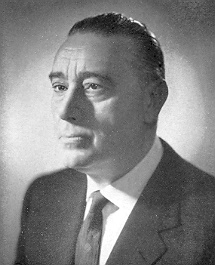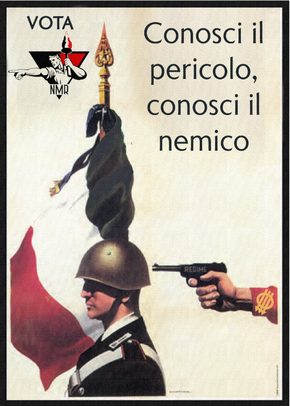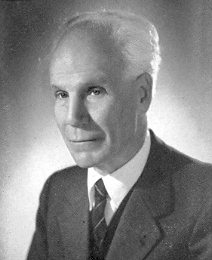User:Tranvea/Sandbox 7
New Republican Movement Nuovo Movimento Repubblicano | |
|---|---|
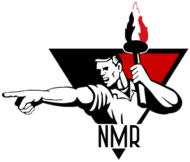 | |
| Abbreviation | NMR |
| Leader | Giorgio Garafola Giosuè Fioriti Goran Jurić |
| Founded | March 15, 1947 |
| Dissolved | October 9, 1986 |
| Merger of | National Solarian Party Etrurian Patriotic Worker's Party |
| Succeeded by | National Democratic Party Social Party-Caccio National League for Etruria |
| Headquarters | Palazzo Maschera, Solaria |
| Newspaper | La Fiamma (The Flame) |
| Youth wing | Nuova Gioventù Repubblicana ("New Republican Youth") |
| Paramilitary | Custodes (alleged) |
| Membership | 405,302 (1986) 849,500 (peak, 1958) |
| Ideology | Etrurian nationalism Neo-national solarianism Neo-functionalism National conservatism |
| Political position | Right-wing to Far-right |
| Religion | Solarian Catholicism |
| Colours | black |
| Anthem | Bandiera Tricolore "Tricoloured Flag" |
The New Republican Movement (Vespasian: Nuovo Movimento Repubblicano), also known by the abbreviation NMR, was a far-right Etrurian nationalist party that existed from 1947 to 1986. It officially declared itself a "patriotic national conservative party" but espoused policies and ideologies closer to nationalism, Neo-Functionalism and Neo-National Solarianism. The NMR played a pivotal role during the Etrurian Third Republic and its support for the 1960 Etrurian coup d’état led to many of its promiment members being given positions in the subsequent military junta. It is widely accredited for the rehabilitation of the Etrurian far-right in the post-Solarian War period and the failure of Etruria coming to terms with its far-right past and historic war crimes.
Established in 1947 through the merge of the National Solarian Party and Etrurian Patriotic Worker's Party; two successor parties to the Revolutionary Legion, that ruled the Greater Solarian Republic (1938-1946). The establishment followed other parties who formed the same year in anticipation of the dissolution of the Community of Nations-led provisional government, and elections in late 1947. The establishment of the NMR caused controversy, owing to thread connecting the party with the Revolutionary Legion, despite this, the party was permitted by the provisional government in anticipation and expectation it would be exiled to the political fringe due to the legacy of the GSR and the Solarian War.
In the 1947 Etrurian general election, the NMR under leader Giorgio Garafola won 19 seats, coming fifth in the vote, by advocating mostly a more statist approach to reconstruction and combatting the rise of far-left politics. Between 1948 and 1950, the NMR under Garafola restrained from following the immediate culture of opportunism and vicious inter-party fighting, regularly denouncing the chaotic legislature as “condemning Etrurian recovery.” The policy of the NMR “acting responsibly and respectably” in comparison to the other parties, greatly aided the party in securing soaring popularity. The endemic corruption of the Third Republic coupled with the crippling instability and weakness of successive governments led to the NMR rising to be one of the most powerful and influential entities in Etrurian politics by 1953.
In 1954, the NMR became the second largest party in that year’s election, winning 36 seats. In one of the most pivotal moments of the Third Republic era, the NMR, in exchange for supplying votes for the year’s budget, secured from President Ferdinando Grillo, the dissolution of the National Tribunal for Historic War Crimes and Incidents, a body established in 1946 to prosecute mid and low-level GSR officials for crimes against humanity. In 1955, the entered into coalition with parties aligned with Grillo and securing the revision of history textbooks, whitewashing the Solarian War, passing a law criminalising accusation of crimes against humanity made by Etrurian citizens and lifted the ban on GSR-era symbols and images.
In late 1956, they abandoned the Grillo government, orchestrating its collapse and his removal from office by no-confidence vote due to his inability to confront the rising threat of far-left separatist movements in Carinthia and Novalia. Garafola led the NMR in becoming outspoken hawks on the Western Emergency and by 1958 began secretly advocating military rule. The pro-junta approach of Garafola secured the NMR’s leadership positions of power within the military government (1960-1984). However, their allegiance and participation in the junta would lead to its rapid decline and eventual collapse following the restoration of democracy in 1984. In the elections held that year, the NMR failed to win a single seat. The same year, it fractured into the National Democratic Party, Social Party-Caccio, National League for Etruria.
History
Formation
In wake of the collapse of the Greater Solarian Republic in 1946 and the ruling Revolutionary Legion, many of its mid-level officials went into hiding, just as the highest-ranking members who survived the collapse, were arrested for war crimes by the Community of Nations. The near exclusive focus of the CN Coalition on apprehending high ranking officials, essentially preserved the Revolutionary Legion through its surviving members, many of whom established splinter parties in 1947.
These parties became rallying points for former Revolutionary Legionnaires, war veterans and sympathetic urban and rural workers. In an effort to avoid undue attention from the CN-Provisional government, these parties were outwardly national conservative or Sotirian Democratic. The two main parties to emerge in 1947 as viable entities on the far-right were the National Solarian Party and the Etrurian Patriotic Worker’s Party, led by Viktor Buzolic and Giorgio Garafola respectively. The establishment of the United Socialist Worker’s Party in February 1947, as a umbrella party for the various hard-left and far-left parties in Etruria’s states, so deeply disturbed Buzolic and Garafola they overcame historical and personal animosity to establish the New Republican Movement on 17 March 1947 during a joint congress of both their respective parties.
The formation of a singular party though publicly centre-right, proved to be a lightning rod for former GSR supporters. Within a month, its membership exploded from 3,506 to over 100,000. In preparation for the 1947 elections, the NMR leadership formulated a strategy known as “Imitazione” (Imitation), which would see the NMR run in the year’s elections on a moderate platform, with focuses being on “equal and fair reconstruction, traditional values being restored and national unification from the anger and divisions caused by the GSR’s collapse.” Notably, both Buzolic and Garafola agreed to not put forward a presidential candidate, opting to focus on securing a foothold in the Senate.
1947 Election
During the 1947 election, the NMR campaigned on confronting the “moral and social decline brought about by defeat”, while also offering limited if near constant criticism of the constitution set to come into force on 1 January 1948. However, during the election several NMR candidates made comments or statements indicative of the party’s pro-GSR and neo-functionalist nature, while they were reprimanded, in some regions, it proved beneficial. The party, however, was harmed in terms of support with sporadic incidents of violence between its activists and those of the United Socialist Worker’s Party. In one incident in San Alessandro, two USWP activists were killed when NMR activists shot them with pistols, after the two USWP activists tore down an NMR poster.
The relative message discipline and the moderate platform while reducing the possibility of a crackdown by the provisional government, disappointed a large segment of what would be a fertile voter base, however, the party did succeed in reaching out strongly to Solarian War veterans who found themselves living in depravation and abject poverty, particularly in the cities of Veratia, Palestrina, Andora, San Francesco, Novalia and Torrazza. The party went on to win 6.6% of the vote (2.03 million votes) and 23 seats in the Chamber of the People and 2 seats in the Chamber of the States, one from Il Dogado and the other from Veratia. Overall, the party came sixth, ahead of the United Socialist Worker’s Party, which won 19 seats.
1947-1953
Throughout the First Senate of the Third Republic (1947-1953), the NMR played a relatively cooperative role with the Zaparella-led legislative coalition (comprised of Democratic Action, the Democratic Worker’s Party, with confidence and supply votes from Libertas). Though they often voted in support of the government, this was part of the wider Imitazione policy.
However, the NMR was the first party to lodge a vote of no confidence against Zaparella, when Libertas withdrew from his coalition following a personal scandal engulfing the President in 1950. The NMR vote passed 331-69, ending Zaparella’s presidency. The 1950 Etrurian presidential election resulted in the election of Gabriele Rumor (Democratic Worker’s Party), who failed to secure a coalition with a majority. With the 1950 budget needing to be authorised and fearing that a second government crisis would enable the far-left, the NMR under Garafola successfully rallied the support of the Popular Republican Party and the two Sotirian parties; United Catholic League and the National Sotirian Workers Party to declare their intentions to pass the budget. The NMR’s pragmatic approach to the Rumor-led government in name of the “national interest” resulted in a significant boost to its public image and popularity, which in turn led to the party abandoning Imitazione and only embracing its post-functionalist credentials.
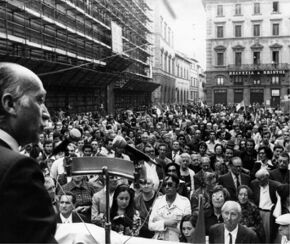
Garafola was boosted also by the rise of a culture of party defections within the Senate. During the First Senate, lawmakers changed parties 119 times in total, often in exchange for monetary or personal benefit. As the number of seats held by the major parties fluctuated on a weekly basis, the stability and loyalty of the NMR, and to an equal extent its nemesis party, the United Socialist Worker’s Party, served to gain public trust. In a speech to supporters in April 1952, Garafola described the Senate as the “most vile place set upon this world, it is a gaping maw of the circles of hell, of which greed has unleashed its denizens, people we call Senators of the Federation.” However, when a group of Senators from the Farmers and Workers Union proposed a law prohibiting crossing-the-floor outright, the NMR conference was whipped to vote against it, owing to the party leadership seeing it as a benefit to its public image in comparison to the fluid opposition.
It was also during the first senate that the party’s links to the Custodes, a paramilitary group involved in often fatal violence against activists of the USWP and other far-left groups. In 1953, several NMR politicians at the state level in Veratia were investigated for supposed membership of the Custodes and the murder of Ronaldo Amate, the left-wing mayor of San Giovanni su Marzio. Though the NMR politicians were later exonerated of any involvement, the incident set the precedent that would long plague the party.
In late 1952, a series of corruption scandals implicating the Democratic Worker’s Party, Democratic Action and the recently established People’s Popular Party (from by a splinter group from Libertas) decimated the centre-left and centre. Within weeks, the NMR had agreed to a coalition agreement with Libertas, of which was likely to win the presidency. Garafola told NMR lawmakers that the coalition agreement would save “Etruria from ruin.”
In early 1953, a crisis erupted around the Rumor-government over the year’s budget. Facing growing tensions within his coalition, particularly his reliance on the USWP, Rumor opted to provide concessions in the budget to maintain his hold on the Senate. Among the proposals was the establishment of a second National Economic Reconstruction Council to be dominated by Trade Unions, the nationalisation all mining companies and the removal of the three-week notice for strike action by government employees. Fearing this to be Rumor’s surrender to far-left radicals, the NMR immediately rejected the proposals and demanded his resignation. In a much referenced and lauded speech, the NMR’s deputy legislative leader, Romolo Arcangelo Quintiliani demanded the resignation of Gabriele Rumor saying, “if the President wishes to confirm his innocence of being a far-left agitator, then he should resign. If he refuses to do so, then let God protect him, for a storm shall be unleashed that will strip the Palazzo Orsini bare of his presence.” Facing the threat of a no-confidence vote, Rumor resigned and was succeeded by Deputy President Nicolo Pazzi. Rumor's resignation before a no-confidence vote could be tabled and passed, maintained the presidential term limit, denying Libertas the opportunity to take the Palazzo Orsini in 1953.
As the 1953 election approached, the NMR departed entirely from its previous policy of Imitazione and began to focus much of its strategy on vociferous criticism of the culture of unrestrained corruption and instability gripping the Third Republic. The widespread resentment and popular anger toward the federal government over consistent failures relating to post-Solarian War reconstruction and the deeply held view of Etrurian society suffering a social and moral decline, fed directly into the NMR and other parties. During the early 1950s, tensions in the western states of Carinthia and Novalia were worsening as popularity for left-wing nationalist groups and movements increased. Garafola came under immense pressure to lift the party’s policy of not fielding a candidate in presidential elections, his own personal popularity was high, as was Quintiliani’s. During the 1952 Party Congress, Garafola and Quintiliani were forced to openly oppose calls for a presidential candidate, with Quintiliani tell delegates, “ours is not to rule, but ours is to protect. From the Senate we can protect the nation from the excesses of the rabid left, the criminally weak centre and the diabolically corrupt centre-right.”
Weeks before campaigning began in mid-1953, the NMR unleashed a torrent of criticism and vitriol both in public events and through a variety of printed materials, condemning the National Tribunal for Historic War Crimes and Incidents, established by President Pazzi. The task of the Tribunal was to arrest and prosecute mid-level officials of the Greater Solarian Republic regime and members of the Revolutionary Legion. While the NMR condemned it as an “attack on veterans”, in truth it was in response to a direct threat to many of its own members and even leader. Much to the NMR’s relief, it had secured the support of Libertas in opposing the Tribunal, with Libertas criticising the Tribunal as a “detriment to national unity during harsh times.”
1953 Election
The 1953 election was one of the most consequential of post-war Etrurian history. The election was defined by the widespread popular anger, resentment, and frustration at the entire political order of the Third Republic. Voters saw a state riddled with corruption, weakness, and impotence, both on reconstruction (economic development) and the rising political tensions in the western states. So severe was corruption in Etruria, that many public officials elected at the local and state level were outright members of the mafia and other organised criminal groups. At the federal level, Libertas was known to utilise its links with organised crime groups to fund its campaigns and to murder rivals or critics. The New Republican Movement, while having limited links to the mafia, was fuelling public anger and by the election, had all but abandoned any effort to avoid revealing its post-functionalist identity.
Garafola, eager not to endanger the coalition agreement with Libertas, focused much of his party’s vitriolic rhetoric against the Third Republic as a whole, the centrist and centre-left parties. Qunitiliani when dispatched to host rallies, defined the 1953 election as the “struggle between Etruria and God, against the Kirenian menace and its puppets.” In a series of posters and pamphlets, the NMR stated that any sizeable vote for the USWP and other far-left parties, would lead to “the inevitable coup by red agents, with the backing and nefarious finances of Amathia and Kirenia. Be brave and beat back the red tide.” Coupled with Libertas’ depiction of Etruria besieged by radicalist leftist groups, the NMR saw a colossal influx of funding and support from Etruria’s wealthy industrialist class.
The NMR’s reach expanded beyond its base in 1947, to now include religious working class and elements of the middle class, who saw the rise of far-left parties as a major threat to national stability. So pronounced was the fear of the far-left, coupled with unbridled anger at the state of the nation, that even as street violence between NMR-linked groups and those of the far-left clashed a daily basis, often with fatalities, its support didn’t decline or waver.
The NMR went into the election championing, anti-corruption, political reform, centralisation and a hard-line crackdown on far-left groups and movements. The NMR remained steadfast despite the controversy it caused with the slogan, “ten years ago this would never have happened!” in reference to the Greater Solarian Republic. In post-election analysis, many then and historians later agreed, that the failures of the Third Republic, the rise of radical leftist groups and the “obscene” level of corruption, gave way to a widespread yearning for the previous regime.
The 1953 legislative election transformed the Etrurian political landscape. The NMR came third with over 20% of the popular vote and gaining 50 seats in the Chamber of the People, gaining 83 overall. It won eight seats in the Chamber of the States bringing its total to 10. With 6.94m votes, it was the largest result for a far-right political party in Etruria until 2016, when the Tribune Movement won over 15.7m votes.
1953-1954
Rapisarda Government
Role within the Military Junta
Decline
Collapse
Organisation
Links to the Custodes
Ideology
Throughout its existence, the NMR proclaimed itself to be a national conservative party and rejected accusations it was far-right or that it endorsed Neo-Functionalism, Neo-National Solarianism or nationalism of any kind. It purposefully maintained vague election manifestos, opting for ill defined themes centred around traditional social and family values, law and order, anti-corruption, patriotism and harsh views toward select minorities (particularly Miruvians).
In every election (1948 and 1954 federally), it advocated a strong federal government and a return to the parliamentary system. It was the harshest critic of the 1948 constitution, regularly decrying it as a “creation of the foreign victors”, and depicting the political chaos caused by its clauses, as the intention of the CN, which intended to use the 1948 constitution as another post-war punishment on Etruria. As part of its advocating of traditional social values, it promoted censorship and strict laws on music, theatre and the emerging television medium. It rejected certain civil liberties, including the abolition of capital punishment, corporal punishment and criticised the freedom of the press as a tool for “socialist extremists to spread lies.” It advocated the banning and prosecution of far-left politicians, activists and hard-line trade union leaders, whom the NMR claimed constituted an existential threat to the Etrurian nation. As the chaos and instability of the Third Republic became manifest further into the 1950s, the party turned toward more populist anti-establishment rhetoric and policies, openly advocated by 1956, for a new constitution outright.
As the Western Emergency began in the mid-1950s, the NMR became the harshest force in the Senate in relation to its daily demands for military deployments and internment. The NMR blamed the 1948 constitution and federalism for the crisis and violence, going as far in 1957 to also begin advocating the abolition of the federal system. The NMR's criticism of federalism would become a staple element of the Etrurian far-right even after the restoration of democracy in 1984. The NMR also promoted the use of Vespasian in all official business across the country, while still protecting Novalian and Carinthian at the state level – in turn rejecting the natural tri-lingualism of Etrurian political discourse. By the late 1950s, so fierce was the NMR’s condemnation of the separatist movements that it openly called for emergency laws permitting the return of torture, detention without trial and some members began to advocate the mass expulsion of the entire Miruvian population from Etruria. The party also became a source for conspiracy theories, blaming the entire emergency on the Miruvian population, who they claimed were taking orders from the Amathian Equalist Republic and Kirenia.
While it rejected claims of supporting Functionalism or National Solarianism many of figures within the party advocated elements of both ideologies. Integral to this was the positive or at least partially positive view of the Greater Solarian Republic and the Revolutionary Legion. This came because of many founding members of the party being former members or officials of the RL, notably, Giorgio Garafola served as the District-Leader of the Revolutionary Legion in Etrurian occupied-Piraea. The party also viewed the Solarian War as a defensive war and propagated lies and misconceptions of the war throughout its existence and rejected claims of war crimes, arguing such accusations were further attempts to punish defeated Etruria. This further fed into the party's veneration of Etruria's war dead and the near constant praise for Etruria’s war effort during the Solarian War. It promoted a policy of “respectful reflection” in which it accepted the need to discuss the GSR’s policies that led to widespread devastation and economic collapse in wake of its defeat, but in practice meant focusing on its successes, policies and key figures. It believed that the display of GSR symbols and imagery was part of reflection and saw the ban on such as incompatible with Etrurian patriotism.
Foreign policy
During its first few years, the NMR’s position on foreign policy was erratic and poorly defined. Several prominent members advocated rapprochement with Eastern Euclea, others promoted a Solarian-Centric policy (focusing on Gaullica, XX, Montecara and Emessa) and others who advocated neutrality and limited international engagement.
Following the 1954 general election and the dominant position of the Garafola faction, the party’s foreign policy was defined more succinctly. The party advocated for membership of the burgeoning Euclean Community and reintegration into Euclea’s order. For a far-right political party in 1950s Euclea, the NMR notably included several key figures who promoted a “union of patriotic and sovereign Euclean nations.” Garafola himself claimed this would be the best protection against “socialism and radicalism.” One reason the NMR abandoned its far-right partners in endorsing the EC was the success of the bloc in rebuilding nations devastated by the Solarian War and the Great War, both of which, Etruria was struggling to do so after two decades.
One prominent faction that maintained itself throughout the party’s life was that advocating a Solarian-centric foreign policy. This faction, led by Arcangelo Adriano Odierno did not necessarily oppose Etrurian membership of the EC, but wished for a regional “focus and new system built around the Solarian World.” The Odierno faction reportedly supported the Gaullo-Etrurian union, though the rest of the party was fiercely opposed. The one thread that united NMR internal factions on foreign policy was the vociferous opposition to socialism and the socialist states of Euclea, notably the Amathian Equalist Republic and Kirenia. Numerous NMR figures would regularly call for an alliance between Eastern Euclea and Soravia against the socialist bloc, leading to strong links between the NMR and Soravian Nationalist and Revivalist Party.
Legacy
Following its collapse in 1984, much of the NMR’s legacy was rooted in its direct involvement and support of the military dictatorship, rather than any specific issue or achievement. As the historical study in the 1990s progressed began to focus on the Etrurian Third Republic, there was a wave of studies into the lasting influence of the NMR.
In 1994, the historian Franco Gugliuzza wrote in his book covering the party, “while so much of the Third Republic can be recognised as a failure of statecraft, the New Republican Movement was the only success story, insofar that it achieved its aims – it halted reconciliation with the horrors of the Greater Solarian Republic, distorted history to protect the GSR and rehabilitated almost certainly guilty war criminals.” The same year, Ferdinando Franceschi, who served as Deputy President under Vincenzo Biava wrote, “the NMR, a most vile party that did more than any entity to facilitate the totalitarian dictatorship of recent times, also did more than any other entity to ensure Etruria was denied the right to de-functionalise, Gaullica took the right path, ours was barricaded shut by enemies of democracy.” The NMR's success in shutting down the National Tribunal for Historic War Crimes and Incidents and lifting the ban on GSR symbols and images played significant roles in the survival of the Etrurian far-right for decades. It's greatest success according to historians, was its brief tenure in running the Federal Ministry of Education, in which it instigated a nation-wide revision of textbooks and teaching guides, whitewashing topics around the Solarian War. The revisionist approach to education was continued under the military government (1960-1984), which was also done in state sanctioned media.
The extent the party succeeded in rehabilitating the far-right, barely a decade after it led Etruria into the death and destruction of the Solarian War was further debated in the 2000s, during which time numerous smaller parties inspired by the NMR grew in popularity. Gugliuzza again wrote a second book on the NMR saying, “as time progresses, we further understand the lasting impact the party had on this country. Where in Gaullica is disgraceful to deny crimes, in Etruria, its disgraceful to suggest them. Where in Gaullica they see their history clearly and with the lasting intention of avoidance, in Etruria, we look to our darkest chapter with reverence and at times, a mournful longing. The NMR is to blame for this, it kept the stain of the GSR where it should not be, in our hearts.”
To right-wing Etrurians, the NMR is viewed more positively. Francesco Carcaterra, when serving as a senior history lecturer at the University of San Michele wrote in 2001, “many can condemn the NMR for its rehabilitation of certain individuals, but many can also thank it for keeping so many weak-willed and often cowardly governments’ feet to the fire. If it were not for the NMR, perhaps the Western Emergency would have been shorter and more successful for the separatist.”
The party’s ideology and electoral strategies were emulated by its successor parties and future far-right parties, including the Tribune Movement. While some far-right parties sought to distance themselves from their own inspiration, many leaders of the Etrurian right would praise the NMR. Gianfranco Galizia in 2018, called it an inspiration for all “patriotic parties in Euclea.”
Electoral history
Chamber of the People
| Election year | Votes | % | Seats | +/− | Leader |
|---|---|---|---|---|---|
| 1947 | 2,004,169 | 6.59% | 23 / 400
|
Giorgio Garafola | |
| 1953 | 6,943,597 | 20.29% | 83 / 400
|
Giorgio Garafola | |
Chamber of the States
| Election year | Votes | % | Seats | +/− | Leader |
|---|---|---|---|---|---|
| 1947 | 2,004,169 | 6.59% | 2 / 30
|
Giorgio Garafola | |
| 1953 | 6,943,597 | 20.29% | 10 / 30
|
Giorgio Garafola | |
